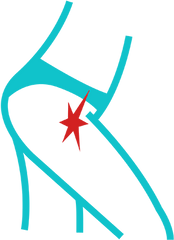A hip flexor muscle is a muscle that functions in flexing the hip - in other words in bringing the knee closer to the chest. This post discusses the 5 major hip flexor muscles and their anatomy - Psoas, Iliacus, Rectus Femoris, Tensor Fasciae Latae, and Sartorius.

Hip Flexor Muscle #1: Psoas
The Psoas muscle is a powerful, deep hip flexor that connects from the lumbar vertebrae to the top of the femur. Psoas functions nearly identical to the Iliacus muscle - and both are often referred to together as the Iliopsoas. Psoas is most active during the top portion of the hip flexion range of motion, when the hip is flexed to 90 degrees (the same position as when sitting in a chair).
Psoas tends to get very tight from excess sitting, and can contribute to a lot of low back and hip pain when it does [1]. To combat this, Psoas release can be very beneficial from a physical or massage therapist, or with a self massage tool like QL Claw.

Psoas Muscle
Hip Flexor Muscle #2: Iliacus
The Iliacus muscle, like Psoas, connects to the top of the femur. However, it has a different attachment above the waist - to the top of the hip. The Iliacus hip flexor muscle is also part of the Iliopsoas, and functions in the same patterns as the Psoas muscle.
Like the other hip flexor muscles, Iliacus can get chronically tight from sitting. When the Iliacus muscle shortens, it has the capacity to develop trigger points and knots, and cause pain the the low back and hips [1]. Iliacus release can relieve a lot of pain and tightness, and can be done effectively at home with a massage tool like QL Claw.

Iliacus Muscle
Hip Flexor Muscle #3: Rectus Femoris
The remaining 3 hip flexor muscles have a different anatomic layout. Instead of inserting at the top of the femur, these 3 hip flexors connect at the knee. It is for this reason that these 3 muscles tend to refer pain further down the leg, and not the lower back like Psoas and Iliacus.
The Rectus Femoris muscle connects from the hip bone to the knee, in the direct front of the thigh [1]. Rectus Femoris is one of the 4 quadriceps muscles, but the only one that functions in hip flexion. Being one of the quadriceps and a hip flexor muscle, Rectus Femoris has two functions: 1) flex at the hip, and 2) extend the knee. Rectus Femoris is engaged intensely when both functions are at play, such as when kicking a soccer ball or swinging a straight leg forward.

Rectus Femoris Muscle
Hip Flexor Muscle #4: Tensor Fasciae Latae
The Tensor Fasciae Latae (TFL) muscle is the outermost hip flexor muscle on the body. TFL consists of a thick, dense bulb-like muscle near the hip bone, and a long tendon - the IT Band - that runs down the thigh to the outer knee.
The TFL muscle has an additional function to hip flexion in single leg stability. When standing on one leg, TFL is active to keep you from falling over. It is for this reason that the TFL muscle is typically very strong and well-developed in runners - running takes place on one leg at a time. TFL can become chronically tight in runners as well. To relieve the tightness in the Tensor Fasciae Latae, a deep tissue massage by a tool such as QL Claw can be very beneficial.

Tensor Fasciae Latae (TFL) Muscle
Hip Flexor Muscle #5: Sartorius
The final hip flexor muscle is the Sartorius. Sartorius is the longest muscle on the body and the innermost hip flexor muscle [1]. Sartorius connects from the hip bone, across the thigh, all the way to the inner knee (Tibia) [1]. Like with Rectus Femoris, great effort from Sartorius is required during a soccer kick - particularly when kicking across the body.

Sartorius Muscle
Thank you for reading and learning about hip flexor muscle anatomy! Read next:
Hip Flexor Muscles FAQ:
What Are Hip Flexor Muscles?
Hip flexor muscles are the muscles around the thigh that flex the hip - which looks like bringing the knee towards the chest. The 5 main hip flexor muscles are Psoas, Iliacus, Rectus Femoris, TFL, and Sartorius.
How To Stretch Hip Flexor Muscles:
Since the hip flexors function in hip flexion when they contract (bring the knee to the chest), we stretch them by getting into hip extension. Some examples of hip flexor stretches include the upward dog, couch stretch, and spiderman stretch.
Where Are The Hip Flexor Muscles?
All hip flexors are in the front of the body around the thigh. The top 2 hip felxors - Psoas and Iliacus - live near the crease of the hip, while the bottom 3 - Rectus Femoris, TFL, and Sartorius - connect from the top of the thigh to the knee.
What Is Hip Flexor Muscle Anatomy?
Scroll up for images, functions, and more on the anatomy of the 5 major hip flexor muscles!
Now that you've read about hip flexor muscles, check out our page on the benefits of a rectus femoris stretch!
Sources:
[1] Davies, Clair, and Amber Davies. The Trigger Point Therapy Workbook: Your Self-Treatment Guide for Pain Relief. 3rd ed., New Harbinger Publications, Inc., 2013.


